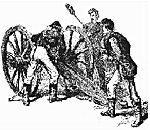
John J. Henry. Return To Bull Run: The Campaign and Battle of Second Manassas. New York: Simon & Schuster, 1994. 472 pages.
Return To Bull Run is the first book in more than a century to give a detailed account of one of the most important campaigns of the eastern theater in the American Civil War. The Battle of Second Bull Run is usually overshadowed by the Seven Days before it, and Antietam after it. John J. Hennnessy, former historian to the Manassas Battlefield Park, gives a comprehensive account of the first critical campaign conducted by Robert E. Lee’s Army of Northern Virginia, and John Pope’s failure as the commander of the Army of Virginia.
President Lincoln appointed Pope to command the Army of Virginia after the failure of George E. McClellan on the Peninsula. Pope’s job would be to bring the war to the citizens of Virginia. The stakes were high, for this was a highly controversial approach. Only a victory would justify the departure of the more conservative approach of non-civilian involvement.
The story of Pope epitomizes the lack of Union leadership before the arrival of Ulysses S. Grant. Jealousy and backbiting prevailed among the Union generals. Pope’s personality and proclivity for self-promotion caused deep division among the rank of officers. Pope could have succeeded on his mission. The campaign was lost by Pope’s obsession for the annihilation of Thomas J. Jackson’s army and his complete neglect for the position of James Longstreet.
Hennessy tells the story of the emergence of Lee as a field general. He documents the strategic plans of Lee, Longstreet, Jackson, and J.E.B. Stuart to force Pope out of Virginia. The author does not dwell into the personalities of the Confederate generals but presents the high risks taken to accomplish the goal of ridding Virginia of the “miscreant” Pope. Jackson would arc right around the Union soldiers and cut their supply line at the Orange Alexandria Railroad. Lee and Longstreet would create a diversion to cover Jackson’s movement. Later, Lee and Longstreet would march Longstreet’s divisions to Thoroughfare Gap. Then, they would unite with Jackson and force Pope into a battle before he had a chance to join forces with McClellan’s Army of the Potomac. If the plan had failed, Lee’s army would have been cut into with the whole force of the Union army between them.
Hennessy provides the right amount of detail to satisfy any reader. The book contains copious annotations, references, and maps. For the reader interested in the human side of history, the book is a fascinating story of characters and personal aspects of the campaign. One of the interesting incidents involved Stuart losing his hat in a skirmish at Verdiersville. The Yankees caught Stuart and his comrades asleep. Stuart had to flee for his life leaving his hat behind which became the property of the Army of Virginia. This was an embarrassment of the first order to Stuart. When the Confederates captured a supply train containing Pope’s dress uniform coat, it must have been a wonderful day for Stuart. Stuart wrote Pope a letter offering to trade.
Pope did not reply.
One of the most stirring passages written in the book is about the day of August 27th. Hennessy states this is one of the most documented days of the war. Jackson’s men had captured Manassas Junction. The march had been long and hard. The men had marched fifty-four miles in thirty-six hours. The men had been hungry for days. The Junction was a cornucopia of provisions. “To see a starving man eating lobster salad and drinking Rhine wine, barefoot and in tatters, was curious; the whole thing was indescribable” (P. 130). The reader is never allowed to forget men and boys with hopes and fears fought and suffered at Bull Run.
This book actually reads more like a novel, with the exception of the major detail supplied for the battles. For those that are not fanatical in seeking knowledge of minute military strategies, these sections may prove to be tedious reading. The maps are confusing, not enough space for different army positions is allowed. In conclusion, I would recommend this book. Return to Bull Run is well written and documented. The aficionado as well as the novice would learn from Hennessy and enjoy the process.
Back to Cry Havoc #34 Table of Contents
Back to Cry Havoc List of Issues
Back to MagWeb Master Magazine List
© Copyright 2001 by David W. Tschanz.
This article appears in MagWeb (Magazine Web) on the Internet World Wide Web. Other military history articles and gaming articles are available at http://www.magweb.com